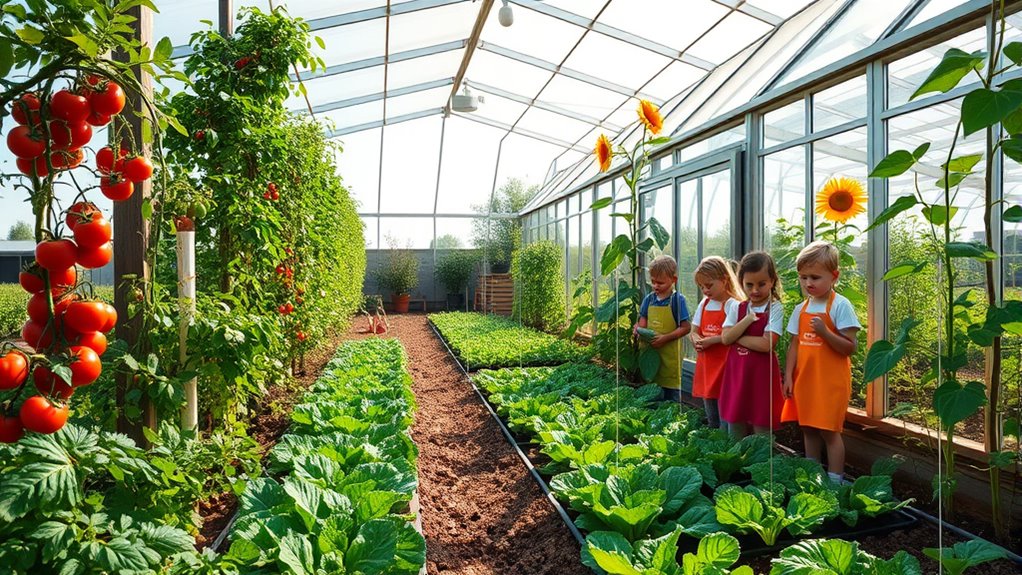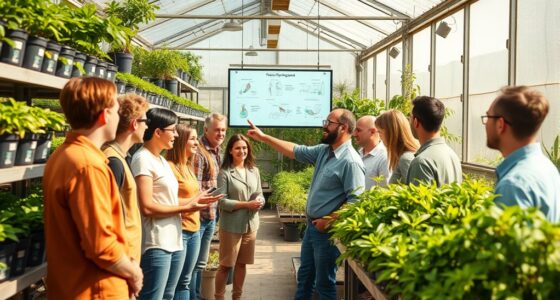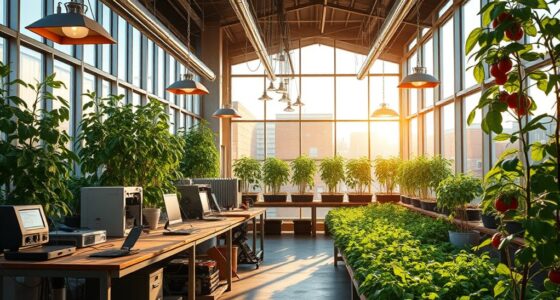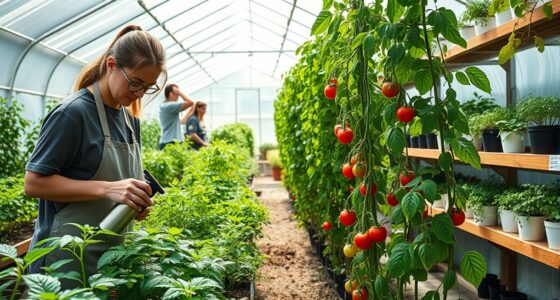School gardens and greenhouses give you a hands-on way to learn sustainability by actively growing food. You get to connect with nature through planting, watering, and harvesting, which deepens your understanding of plant needs and environmental care. Using technology like automated systems makes your efforts more efficient and educational. Working with others builds teamwork skills and highlights how individual actions impact the environment. Keep exploring to discover even more ways these gardens foster lifelong ecological responsibility.
Key Takeaways
- School gardens provide hands-on experiences that teach students about plant growth, environmental needs, and sustainability practices.
- Growing food in school greenhouses fosters environmental stewardship and encourages sustainable habits like composting and water conservation.
- Integration of technology, such as automated watering and sensors, enhances learning about plant adaptation and resource management.
- Collaborative garden activities promote teamwork, responsibility, and understanding of ecological balance and collective sustainability efforts.
- Engaging students in food cultivation nurtures environmental awareness and lifelong commitment to sustainable living practices.

School gardens and greenhouses offer hands-on learning experiences that connect students with nature and science. When you involve students in maintaining these spaces, they learn about plant maintenance firsthand. They discover how plants need water, sunlight, and nutrients to thrive, and they learn to recognize signs of pests or disease. This practical approach helps students understand the science behind plant growth, creating a deeper connection to the environment. As they water, weed, prune, and monitor their plants, students develop responsibility and patience. They quickly realize that caring for a garden requires consistent effort and attention, reinforcing the importance of stewardship and sustainability. Integrating automation technologies into garden management can further enhance efficiency and learning opportunities. These technologies can include automated watering systems and sensors that help students observe environmental changes in real-time. Additionally, understanding plant biology deepens students’ knowledge of plant processes and adaptation strategies.
Your students’ engagement deepens through active participation. When they handle tasks like planting seeds, watering seedlings, or harvesting vegetables, they become more invested in the process. This hands-on involvement sparks curiosity and enthusiasm, making learning fun and meaningful. As students see the fruits of their labor—literally—they gain a sense of achievement, which motivates them to keep exploring. The more they engage with gardening activities, the more they understand ecological cycles, food systems, and the importance of sustainable practices. You’ll notice that students who participate regularly tend to ask more questions, seek to learn more about plant biology, and become advocates for environmental responsibility.
Active gardening boosts student curiosity, achievement, and understanding of ecological cycles and sustainability.
Involving students in plant maintenance also creates opportunities for teamwork. They learn to work together, share responsibilities, and solve problems collaboratively. For instance, they might plan a watering schedule or troubleshoot why certain plants aren’t growing as expected. These tasks help build communication skills and foster a sense of community. Students see firsthand how their actions impact the garden’s health, encouraging accountability and teamwork. The collaborative nature of gardening makes lessons about sustainability practical and relatable, showing students that caring for the environment is a shared responsibility. Additionally, understanding ecosystem interactions helps students grasp the complexities of ecological relationships and growth processes.
Furthermore, engaging students in garden maintenance helps instill a lifelong appreciation for nature. As they observe the growth process and experience the satisfaction of nurturing life, they develop a stronger environmental ethic. This connection can inspire them to adopt sustainable habits beyond the classroom, like composting, conserving water, or reducing waste. Your role in guiding students through plant maintenance not only teaches them about horticulture but also cultivates a mindset that values sustainability and ecological balance. Overall, involving students actively in garden care transforms learning into a dynamic, impactful experience that promotes environmental stewardship and personal growth.
Frequently Asked Questions
How Do School Gardens Impact Student Academic Performance?
You might wonder how school gardens impact student academic performance. These gardens boost student engagement, making learning more interactive and enjoyable. As a result, students experience enhanced cognitive development because hands-on activities stimulate their brains. When you incorporate gardens into education, you create a dynamic environment that encourages curiosity and critical thinking, ultimately improving academic results and fostering a lifelong love of learning.
What Are the Initial Costs to Start a School Garden or Greenhouse?
While the initial costs of starting a school garden or greenhouse might seem high, they’re an investment in your students’ future. You’ll need to contemplate budget considerations and explore funding sources like grants, community donations, or school budgets. These upfront expenses cover supplies, tools, and setup, but the long-term educational and environmental benefits make it worthwhile. With proper planning, you can create a thriving garden without overspending.
How Can Schools Involve the Entire Community in Gardening Projects?
You can boost community involvement by organizing volunteer programs and inviting local residents, parents, and businesses to participate. Host workshops, garden days, or open house events to engage everyone and showcase progress. Create partnerships with local organizations to support supplies and funding. Communicating regularly through social media or newsletters keeps the community informed and invested, fostering a sense of ownership and pride in the gardening projects.
What Are Effective Ways to Maintain Student Interest in Gardening Long-Term?
You might think keeping student engagement alive is impossible, but it’s not! You can make gardening irresistible by integrating it into your curriculum, turning lessons into hands-on adventures. Regularly introduce new projects or competitions to spark excitement, and celebrate every small victory. By connecting gardening to students’ lives and making it relevant, you’ll maintain their interest long-term, creating a garden-filled passion that grows just like the plants themselves.
How Do Gardens and Greenhouses Contribute to Environmental Education?
You see, gardens and greenhouses serve as hands-on tools for environmental education. They let you explore soil health firsthand and understand the importance of biodiversity enhancement. By engaging in planting and maintenance, you learn about ecosystems and sustainability. These spaces inspire curiosity about environmental issues, encouraging you to adopt eco-friendly practices while fostering a deeper appreciation for nature’s complexity and the need to protect it.
Conclusion
By participating in school gardens and greenhouses, you help nurture the next generation’s understanding of sustainability. Imagine students planting seeds that grow into vegetables, teaching them to care for the environment. Did you know that schools with gardens see up to 70% more engagement in science lessons? Your involvement can turn simple planting into powerful lessons, inspiring kids to grow not just food, but a greener future for everyone.










